
Sumoroku
Welcome to Sumoroku–the sumo-themed sugoroku! Sugoroku is a type of Japanese board game with a very simple premise: reach the end. While playing sugoroku may be a breeze, life as a rikishi fighting his way to the top is anything but. In this game, you will follow our rikishi’s arduous journey from humble beginnings to the very pinnacle of professional sumo. You will be given a glimpse into the life and tradition surrounding sumo through various minigames, diary entries, and informational excerpts. So, rise and shine, new recruit! It’s time to don your mawashi and show us all what you’re made of.
Disclaimer: While all the images on this sugoroku board depict sumo in the late nineteenth century, some are anachronistic.
The Sumoroku Team was
Vu Du
Kanaan Macias
Matthew Peterson
Sarah Rosseau
Dr Colton Runyan
-

1 ふりだし ー 振り出し ー Starting point
An aspiring rikishi, or sumo wrestler, leaves his home behind with only the necessities in a small cloth bag known as a furoshiki. He is traveling to Edo in hopes of finding a heya in which to train.
Narrative: The sun is setting and my decision is finally sinking in. I have decided to pursue the path of a rikishi and have left everything that I know behind to fulfill this dream. All I have with me is a small furoshiki filled with a few necessities. It's grown even lighter as I have had to sell my extra layers to afford a simple meal and there is not enough left to stay in an inn for even one night. This journey will be a tough one, but I am determined to achieve my dream of becoming the grand champion–the yokozuna. To do so, I will face any and all challenges that come my way. For now, I will focus on becoming a rikishi, only then will my journey truly begin.
-

2 のじゅく ー 野宿 ー Sleeping outdoors
On the trip to Edo, he has no choice but to sleep outdoors. This image illustrates the significant hardship aspiring rikishi endure before they even begin formal training.
Narrative: I’ve decided to set up camp under a tree tonight because I don’t have enough funds to purchase a bed at an inn. The ground is hard, but it’s nothing that I can’t handle. My furoshiki is set on top of my chest so that I can hold onto it as I sleep. It’s not the best protective measure but it will have to do for now.
-

3 にほんばし ー 日本橋 ー Nihonbashi, district of Edo
The aspiring rikishi arrives at Nihonbashi, the trade and cultural center of Edo. Almost half of the population of Edo lives around this area, making it an ideal place to find a crowd of financially well-off citizens that have little trouble paying to watch sumo matches.
Narrative: I’ve arrived at Nihonbashi, and it is filled with bustling commotion. So many people are traveling to and fro while merchants line the street to hawk their wares. The area is known for being a great place to watch sumo matches, and the idea fills me with excitement. I want to be up there competing against other rikishi, throwing my opponents to the ground as the crowds cheer…I can’t wait!
-

4 ふれだいこ ー 触れ太鼓 ー Drumming in the streets to announce a tournament
Yobidashi travel over the Nihonbashi bridge to announce information about a new sumo tournament. Because there was no other reliable way to distribute the news, they would parade around the city sounding taiko drums to attract attention. Modern day yobidashi do something similar for the dohyō matsuri ceremony – they circle around the dohyō three times, then head out towards the heya to publicly announce the start of a tournament.
Narrative: It seems the yobidashi are announcing the tournament today. I knew they were here as soon as I heard the taiko drums. Soon after, they bellowed the news about the start of the tournament as their voices echoed throughout the streets. I can feel my body shaking in anticipation for what’s to come!
-

5 ばしょいり ー 場所入り ー Rikishi arrive at the tournament venue
As the sekitori arrive at the tournament, they are accompanied by lower-division rikishi acting as their assistants, known as tsukebito, who carry their possessions in an akeni. A tsukebito is generally responsible for all of his senior’s day-to-day needs. During the tournament, the tsukebito can be seen carrying a cushion in and out of the arena for his superior.
Narrative: I am at Ekō-in Temple where the tournament is taking place. Rikishi are filing in, with the lower ranks carrying the higher ranks’ akeni. They all draw attention from onlookers with their imposing figures. Someday soon, I will walk beside them as an official rikishi.
-

6 りょうごく ー 両国 ー Ryōgoku
Ryōgoku is a district in Tokyo that is home to numerous heya as well as the current and previous iterations of the Ryōgoku Kokugikan–an indoor arena that hosts half of the honbasho held each year. The name Ryōgoku, meaning “two provinces”, stems from a bridge of the same name. The bridge, originally constructed in 1659, connected the provinces of Musashi and Shimosa. The Ryōgoku area is also home to Ekō-in Temple, which was the venue for sumo tournaments prior to the construction of the original Ryōgoku Kokugikan. Sumo has also influenced local businesses in the area, with a spattering of chanko restaurants and many other sumo-related shops and attractions.
Narrative: I have finally made it to Ryōgoku. As I walk around, I can’t help but imagine myself training with my stablemates in a heya. The Ekō-in Temple is truly a sight to behold, more impressive than any structure I have seen so far. I will have to fight with all of my might to become an official rikishi, but I am determined and willing to risk it all for my goal.
-

7 にゅうもん ー 入門 ー Beginning Training
New rikishi start their training at the bottom. Recruits are expected to have additional duties on top of their daily training regimens. They are tasked with preparing the dohyō every morning prior to practice as well as other menial chores such as cleaning and doing laundry. Younger rikishi are the last to eat their meals, being forced to eat whatever chanko is leftover after their superiors have had their fill. Hazing of the younger, newer members of the heya is not an uncommon practice. Newer recruits are sometimes tasked with assisting larger, senior rikishi who would otherwise have difficulty performing tasks related to maintaining hygiene such as bathing or wiping their behind. Once rikishi climb the ranks, they shed most of these duties.
Narrative: I’ve finally become an official rikishi! Now I have to focus on training hard to make sure that I can quickly rise the ranks of professional sumo and increase my standing within my heya. Once I do that, I can focus more on training without having to deal with all the extra chores.
-

8 そうじせんたく ー 掃除洗濯 ー Doing (Cleaning) Laundry
In addition to their other responsibilities, lower-ranked rikishi are responsible for all the cleaning and laundry at the heya. This includes cleaning the mawashi of their stablemates by hand.
Narrative: Today is laundry day, and those of us in the lower ranks are in charge of cleaning our superior’s mawashi. The process is long and grueling and it makes me look forward to moving up even more. For now, I will have to finish as fast as I can and get back to practicing to make sure that I get promoted as quickly as possible.
-
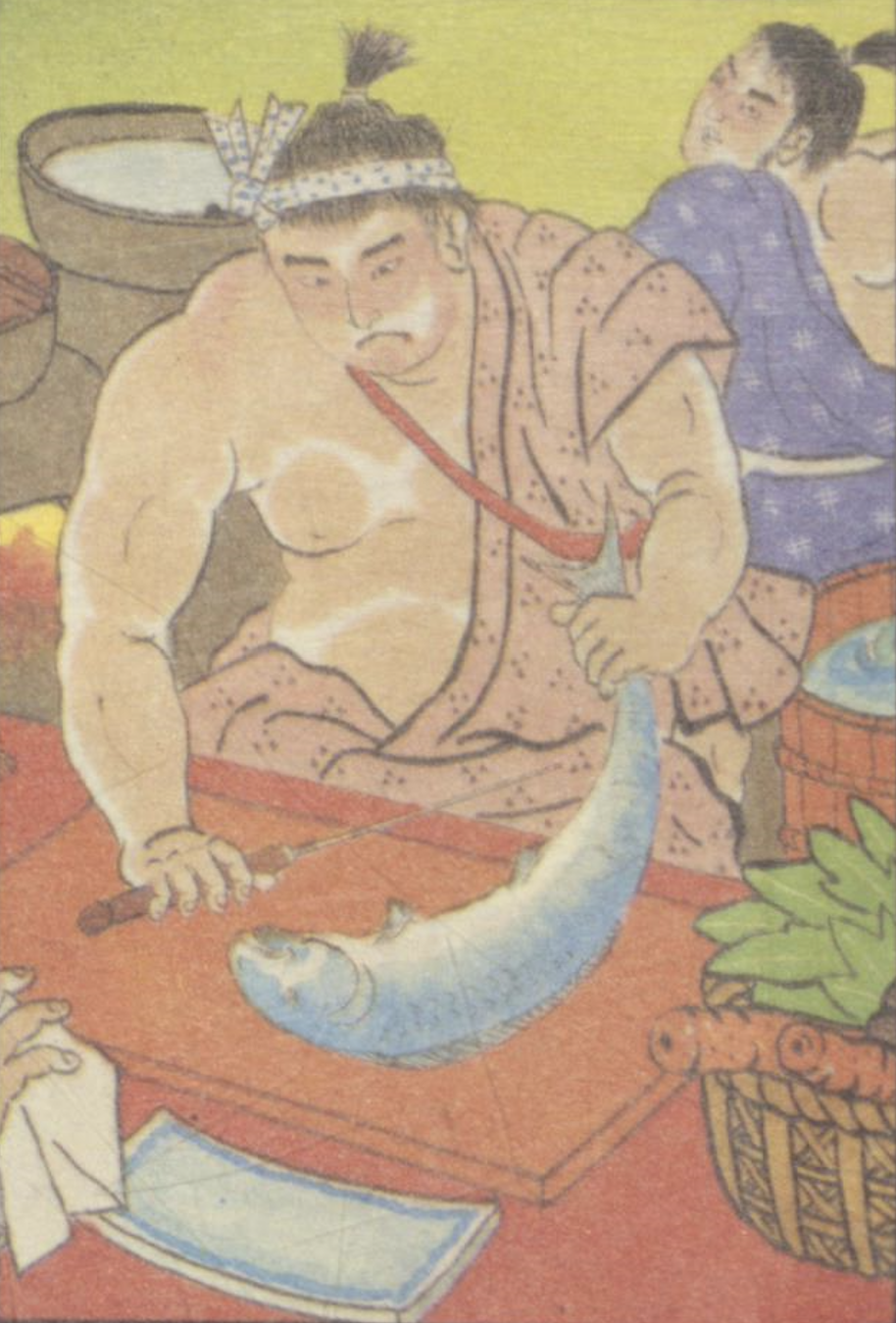
9 ちゃんこ ー Sumo dishes
Chanko is the general term for dishes eaten by rikishi. It can contain curried rice, spaghetti, ramen noodles, etc. Anything prepared by the chanko-ban, the cook of the heya, is called chanko. That said, the primary meal eaten by rikishi every day is called chankonabe–a “one-pot” stew version of chanko. Meat and seafood are commonly used to provide protein while the vegetables used vary based on what’s available. The dish can be seasoned with broths, soy sauce, mirin, or other condiments.
Narrative: The lower ranks have to prepare the food for our heya, and today we made a nabe with fish. Once I rise in rank, I’ll be able to get the best parts instead of the leftovers. My first tournament is coming soon. I can’t wait!
-

10 にもつはこび ー 荷物運び ー Carrying Luggage
The possessions of rikishi and top-ranked gyōji are stored and carried in lacquered paper-and-bamboo boxes called akeni. All akeni bear the owner’s name on the side and have the same color scheme of green, vermilion, and black. Yokozuna are allowed to use up to three akeni because they have more regalia. Akeni have no locking mechanism, instead consisting of a top section that simply slides over the bottom section. Traditionally made akeni are expensive and only made for members of the Sumo Association. But, fans may purchase plastic tissue boxes designed to look like akeni with the names of their favorite rikishi on the side.
Narrative: I have been given the duty of carrying one of the more advanced rikishi’s akeni. The box is definitely something to marvel at, but it will no doubt pale in comparison to the one I will eventually earn. I am looking forward to that day, but to get there I need to hone my skills and advance ranks first.
-

11 かえろかな ー Maybe I should return home
The difficulty of being a rikishi can take its toll, causing some to consider leaving. Some rikishi who leave may be tracked down by their stablemates and forced to return, while others will be forever barred from returning if they regret their decision. The text reads “If you land here, go back to start”
Narrative: Recently I have been questioning if I truly made the right choice to become a rikishi. The process has been more difficult than I imagined and sometimes I long for home. But these thoughts are not acceptable and I need to train my mind and heart. To do so I need to go back to the beginning and remind myself why I embarked on this journey in the first place. Only once I have regained my resolve will I be able to achieve my goal.
-

12 あさげいこ ー 朝稽古 ー Early morning practice
Practices start bright and early at around 5 A.M. Every practice begins with various exercises designed to increase strength and improve balance and flexibility. The most fundamental exercise is shiko, which is performed hundreds of times each day. Other exercises performed regularly include teppō and matawari. Once the exercise portion of practice is complete, rikishi move on to moshiai. Moshiai is a king-of-the-hill-style drill where rikishi engage in practice matches in which the winner remains until he loses. Rikishi also engage in a drill known as butsukari, where one rikishi pushes another across the dohyō. The rikishi that is being pushed acts as resistance but does not push back. Sumo practices are very demanding and leave rikishi exhausted by the end.
Narrative: The lower-division practices start before the sun rises. The hundreds of shiko cause my knees to shake until my legs feel like they will give out. During the moshiai matches, I am thrown to the ground by the more skilled wrestlers over and over again without rest. The butsukari feel like trying to push an unyielding mountain. Every practice takes all that I have out of me. My blood, sweat, and tears have soaked into the unforgiving clay of the ring. Despite this, I am determined to improve with every practice. I will persevere until I am the better wrestler, toppling my opponents and rising within my heya and professional sumo.
-

13 もうげいこ ー もう稽古 ー More Practice
Even after hours of grueling practice in the morning, some rikishi continue to practice at night in hopes of gaining an edge over their stablemates.
Narrative: I don’t care how exhausted I am after morning practice and all my chores, I need to practice more. I will join a few other determined rikishi for another round of training on the dohyō. This extra practice will get me one step closer to my goal, which is more than enough of a reason for me to press on past my exhaustion and get back to work.
-

14 もちつき ー 餅つき ー Mochi (rice cake) pounding
Mochi-tsuki, or pounding rice to make mochi rice cakes, is a Japanese tradition usually performed around Christmas time in preparation for the New Year. The act of making mochi involves two people, one who pounds the special sticky rice with a heavy wooden hammer while the other regularly shifts the rice in the large wood or stone bowl to maintain evenness. The act of making your own mochi has steadily declined over the years as most people in Japan opt to order their mochi from specialty shops or buy machine-made mochi from supermarkets. The mochi is cooked and eaten on New Year’s Day.
Narrative: The time has come to help make mochi for New Year’s. This is one of my favorite times of the year because I have always loved the taste of mochi. I am excited to help make it this year because the technique required seems like a new form of exercise. I wonder how much I could make in one sitting…
-

15 のみくらべ ー 飲み比べ ー Drinking Competition
Rikishi are known to consume copious amounts of alcohol to increase their caloric intake and appetite. They also use alcohol to help dull the aches and pains of practice. The text reads “Drank too much, rest for one turn”
Narrative:
Ugh, my head is pounding this morning, and looking at the light makes me feel sick. Last night, I was so sure I could keep up with my superiors, but this was one match I should have conceded. I am in no position to train today, and I know I am going to get an earful about it. I’ll have to work twice as hard tomorrow.
-

16 じょのくち ー 序ノ口 ー Jonokuchi
Jonokuchi is the lowest division in sumo. This division is primarily comprised of younger rikishi beginning their careers. Older, more experienced rikishi can be found in the lower three divisions by falling from higher ranks, typically due to persistent injury issues preventing participation in multiple tournaments. Promotions from this rank are common due to a steady influx of new recruits. This is the first rank in which rikishi have their names listed on the banzuke.
Narrative: This match will decide if I am promoted to Jonokuchi. It’s my most important match yet, but I am confident in my skills. I will face this challenge head on, and I will win!
-

17 じょにだん ー 序二段 ー Jonidan
Jonidan is the second-lowest division in sumo and one of its largest. This is due, in part, to a cap on the number of rikishi allowed in the divisions above jonidan. Rikishi in this division, as well as all other non-salaried divisions, receive an allowance in exchange for doing chores at their heya. They also receive prize money for winning their matches.
Narrative: I have moved up to jonidan. Not much has changed except a slight bump in my allowance, and I get prize money when I win a match. It’s not a lot, but it is a start. Each yen reminds me that I am on the right track. I just have to keep working hard and take advantage of every opportunity that comes my way.
-

18 さんだんめ ー 三段目 ー Sandanme
Sandanme is the third-lowest division in sumo. Like the divisions below it, sandanme is an unsalaried division filled with mostly young, up-and-coming rikishi. Some rikishi in this division skipped the jonokuchi and jonidan divisions because of a system known as sandanme tsukedashi. This system allows rikishi who place at a certain level in certain amateur or collegiate tournaments to skip the bottom two divisions. Rikishi in sandanme are allowed better-quality attire than their lower-division counterparts. This division has a cap of 180 rikishi. The text reads “Return to jonokuchi due to injury.”
Narrative: I almost reached sandame, but I twisted my ankle in my last match. Now, I am being relegated to jonokuchi. I understand the reasoning, but I am still filled with frustration. Nevertheless, I will recover and come back better than ever before!
-

19 まくした ー 幕下 ー Makushita
Makushita is the third-highest division in sumo. This division is the top of the non-salaried ranks. It is capped at 120 total rikishi. In makushita, and all divisions below it, rikishi participate in seven matches across the fifteen-day basho. Doing particularly well in this division is key, as moving up to jūryō means rikishi will receive a salary. Going undefeated (7-0) grants a rikishi unconditional promotion. Conversely, when a sekitori is relegated to makushita, he loses his salary.
Narrative: I have been promoted to makushita, and I can’t wait for the upcoming tournament. If I do well this time, I will be promoted to jūryō! Then, I will finally receive a salary. My goal is to finish this tournament undefeated, so that there will be no question about my qualifications or readiness for promotion.
-
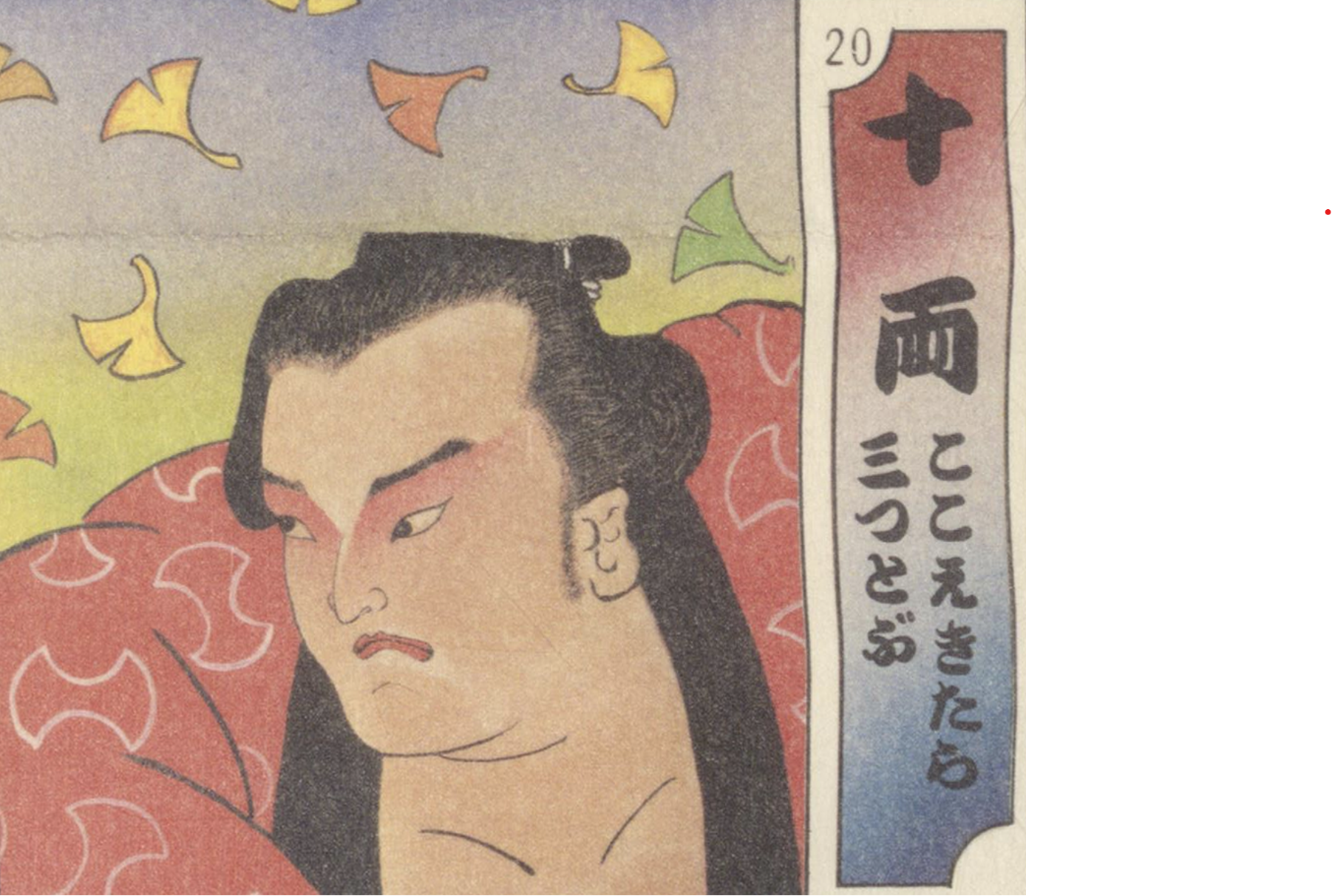
20 じゅうりょう ー 十両 ー Jūryō
Jūryō is the second-highest division in sumo. It is the first of the salaried divisions in sumo. Jūryō is capped at 28 rikishi. The rikishi in this rank and above are considered true professionals, and are otherwise known as sekitori. This division is a mixture of young talent and older rikishi who have fallen from makuuchi. Rikishi in this division and above participate in all fifteen days of a basho. The text reads “If you stop on this tile, advance three spaces.”
Narrative: I have just two matches left, and they will determine whether I advance to jūryō. I have won my other five matches so far, so if I can pull this off, I will finally be in the upper ranks. On top of that, I will finally have a salary! For my next match, I am facing a recently-relegated sekitori. His will to win should not be underestimated. Then again, neither should mine.
-

21 まえがしら ー 前頭 ー Maegashira
Maegashira is the group of “rank-and-file”, or untitled rikishi, in the top division in sumo known as makuuchi. The number of maegashira per tournament varies because of the ever-changing number of title-holding wrestlers in the higher san’yaku ranks, but there are usually 30–34 maegashira rikishi representing the east and west sides. The higher-ranked rikishi in maegashira face the san’yaku rikishi and other higher maegashira. Those in the lower ranks square off against each other as well as the occasional opponent from jūryō if there is an injury. Each rikishi ranked in maegashira makes the same salary, which is higher than jūryō, but lower than san’yaku. If a maegashira rikishi defeats a yokozuna, he receives a kinboshi, or gold star, which comes with a small permanent boost to his salary.
Narrative: If I have a winning record in this tournament, I will finally be promoted from jūryō to maegashira. I have seven wins and seven losses, so my final match will decide my fate. It will not be easy, but I will give it my all.
-
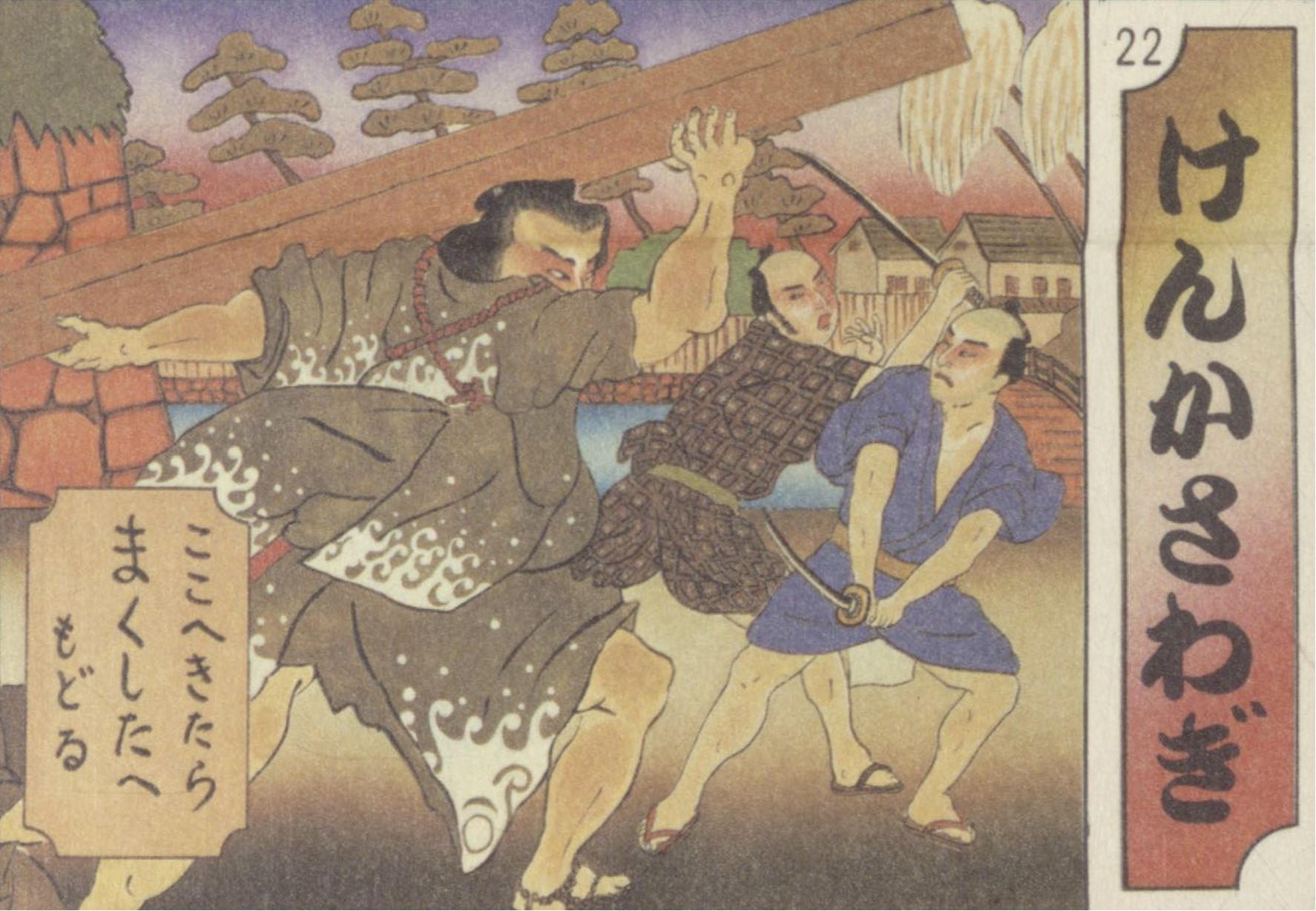
22 けんかさわぎ ー 喧嘩騒ぎ ー Brawl
This tile is a depiction of the Akizuki rebellion, which was an uprising by former samurai against the Meiji government in 1876. Enraged by the government reforms stripping them of their privileged social status, as well as the government-mandated prohibition of swords, several hundred samurai of the Akizuki domain attacked the prefectural office. The rebels were eventually suppressed and captured by the Imperial Japanese Army. This picture suggests that rikishi were involved in the event, but it is unknown to what extent. The text reads “If you land on this tile, return to makushita.”
Narrative: I have been demoted. I was involved in a scuffle where a man sliced my arm. Although there is no long-term damage, I have had to sit out a few tournaments while I recuperate. I am disappointed that I was demoted for actions done outside of sumo, but I know what I must do to regain my position. I have a challenging journey ahead of me, but I will not give up! Soon, the title of maegashira will be mine once more.
-
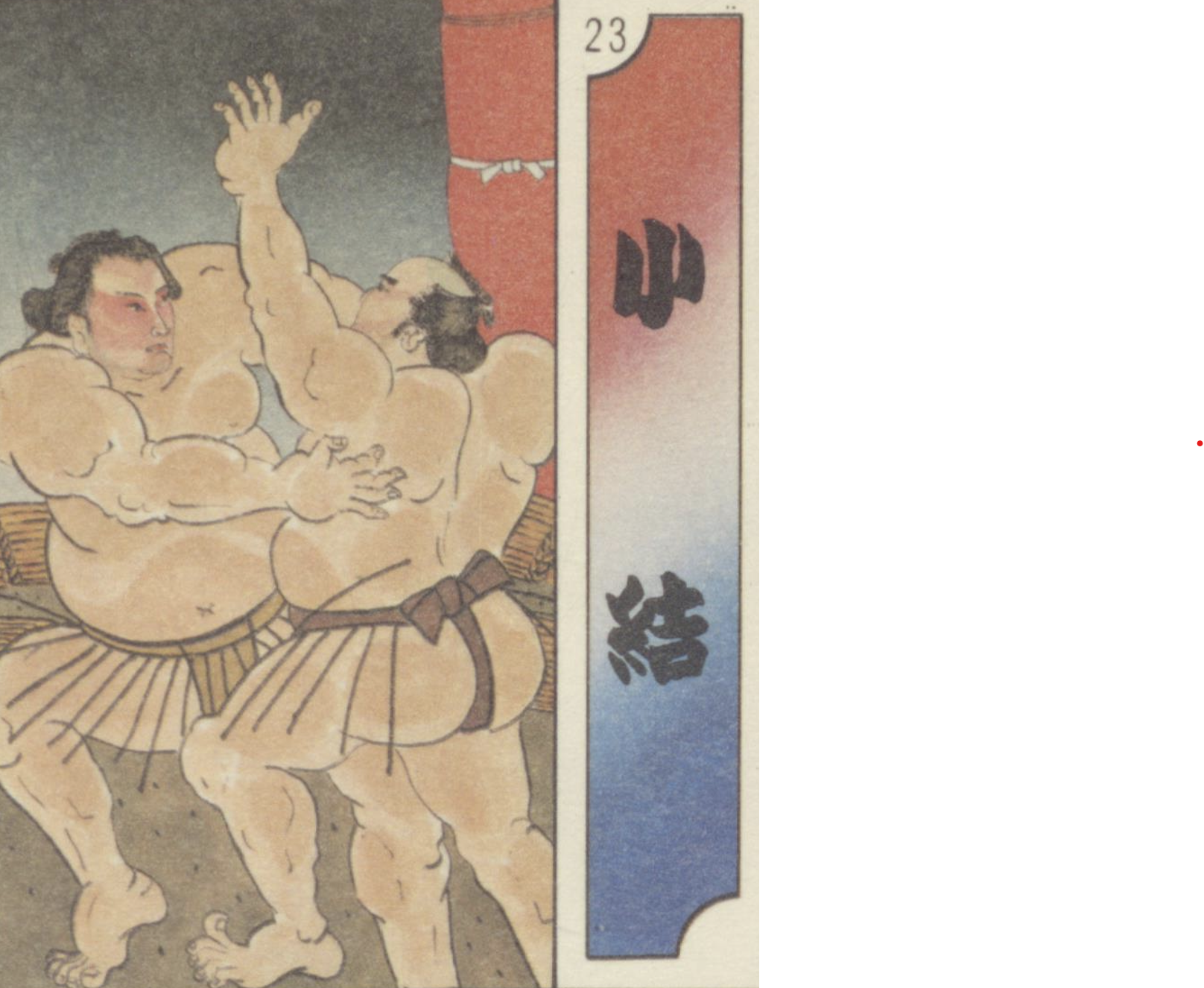
23 こむすび ー 小結 ー Komusubi
Komusubi or “the little knot” is the fourth-highest rank in sumo and the lowest rank of san’yaku. It is considered a difficult rank because komusubi face rikishi from the higher ranks of sekiwake, ōzeki, and yokozuna. Additionally, if there are no open positions at the higher ranks, a rikishi must either wait for an open spot or perform so well that they must be promoted. Being promoted to komusubi includes a salary increase in addition to other benefits related to hairstyle and attire. There are generally 2–3 rikishi holding the rank of komusubi.
Narrative: My next opponent is a sekiwake, and my anticipation is like never before. Winning this match will prove that I deserve to be a komusubi. Whether I am promoted or not, the rest of the san’yaku rikishi better watch out!
-

24 さんやくしゅっせしゅく ー 三役出世祝 ー Celebrating San’yaku Promotion
A rikishi being promoted to san’yaku is a momentous occasion. Thanks to the higher salary for san’yaku rikishi, it is common to have a big celebration at an expensive restaurant for a stablemate’s big promotion.
Narrative: Kanpai! We’re celebrating my san’yaku promotion and it feels amazing to have a night dedicated to the work I have done so far! Not only does it remind me of why I started this journey in the first place, it encourages me to keep pushing onward. My next celebration will be for reaching the rank of yokozuna!
-

25 せきわけ ー 関脇 ー Sekiwake
Sekiwake is the third-highest rank in sumo and the second lowest rank of san’yaku. A komusubi must achieve a kachi-koshi, or winning record in a tournament, to achieve the rank of sekiwake. Much like komusubi, sekiwake may have difficulty being promoted due to the higher level of competition. A traditional cap on the number of rikishi allowed to be ōzeki can also prove to be a barrier preventing promotion. There are generally 2–3 rikishi holding the rank of sekiwake.
Narrative: The opportunity has finally come for me to move up to the rank of sekiwake. All I have to do is win two more matches to achieve a winning record in this tournament. I have been waiting for this chance for so long. I will not let it slip by me! -

26 ふろ ー 風呂 ー Bath
Younger rikishi are traditionally required to bathe their seniors, this is due to both customs around hierarchy and to the sheer size of highly-ranked rikishi. Additionally, higher-ranked rikishi get to bathe before the lower-ranked ones. The number of helpers increases as one goes up in rank. Yokozuna may have more than ten, allowing them to simply stand with their arms stretched out when taking a bath.
Narrative: I overheard some younger rikishi complaining about having to help their senior bathe today. It reminded me of when I first entered the heya. If they don’t like that duty, they must train even harder to rise to the top like I have. Until then, they have no right to object. -

27 おおぜき ー 大関 ー Ōzeki
Ōzeki is the second-highest rank that a rikishi can obtain, just below yokozuna. Promotion to ōzeki takes place over multiple tournaments. Rikishi with the rank of sekiwake are generally considered for promotion after attaining 33 wins over a three-tournament span, but this is not a firmly enforced policy. Other achievements, such as a win against a yokozuna or a yūshō–the term for a tournament victory–factor into ōzeki promotion. There are typically 3–5 ōzeki at any given time.
Narrative: I have managed to secure 32 wins so far, so this next match is crucial. It will not be an easy one, as my opponent is not only an ōzeki, but is looking to win the tournament. He is by far the most skilled rikishi I have had to face so far, but I will not fail here. I am just as determined as he is, and winning this match will guarantee my promotion to ōzeki. As far as I am concerned, losing is simply not an option.
-

28 ほんばしょ ー 本場所 ー Honbasho
A honbasho is an official sumo tournament organized by the Japan Sumo Association. These fifteen-day tournaments are held six times a year, beginning on the second Sunday of odd-numbered months. Three of the six honbasho are situated in Tokyo, with the remaining three taking place in Osaka, Nagoya, and Fukuoka. Rikishi from the top two divisions participate in matches every day of the tournament, while those in the lower divisions have seven matches across the same fifteen-day span. The goal for all rikishi is to finish the tournament with more wins than losses, which is known as kachi-koshi. While there are other tournaments held throughout the year, only honbasho results are used to determine whether a rikishi is promoted or relegated.
Narrative: It is the last day of the tournament. The opposing ōzeki and I are undefeated going into our match today, so the winner takes all. If I win, it will be my second consecutive yūshō, which is the most important criteria for being promoted to yokozuna. My opponent, however, is perhaps the greatest rikishi I have ever faced. He had to withdraw before our match during the last tournament when I won my first yūshō. This time, I’ll prove that I deserve to be a yokozuna.
-
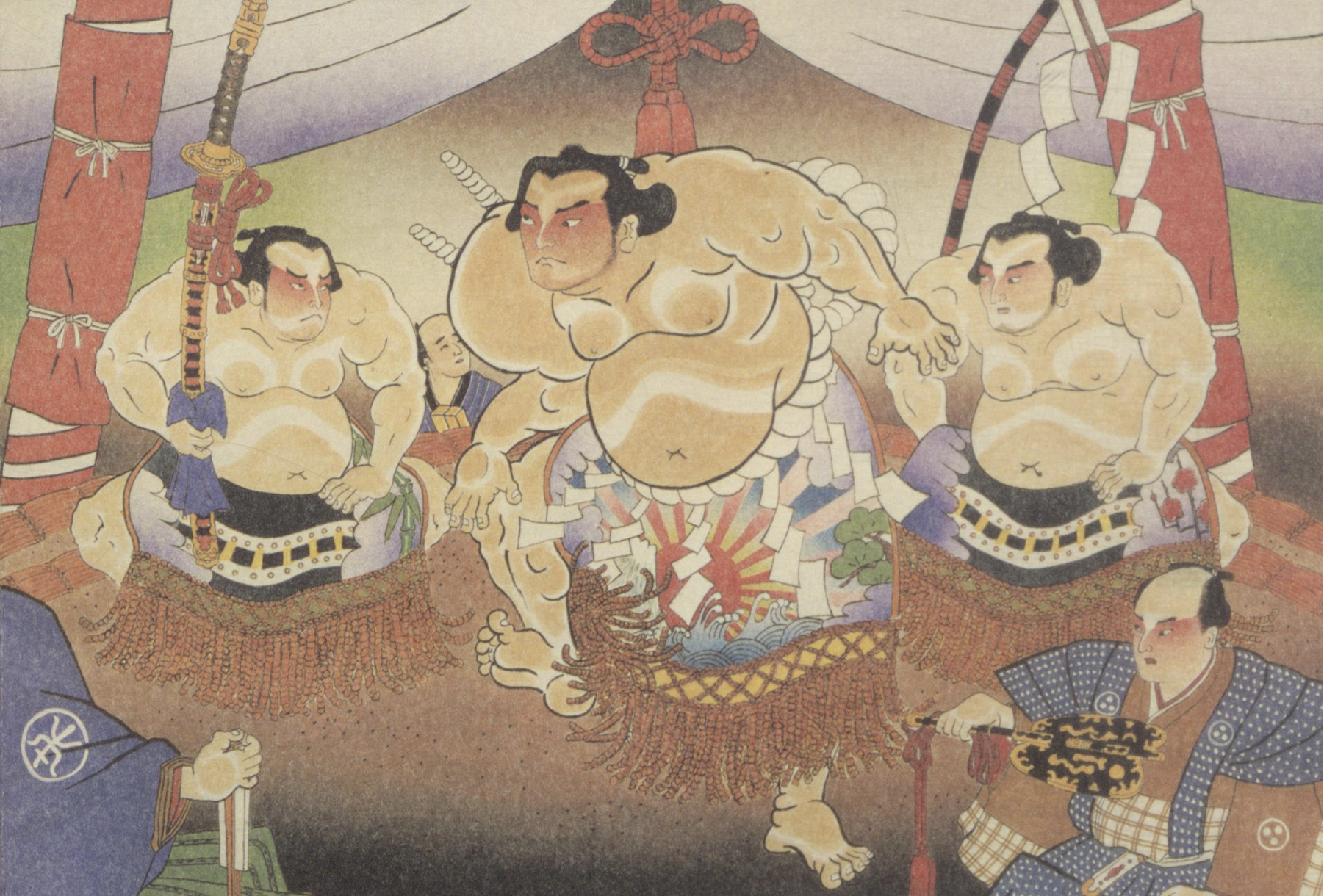
29 横綱土俵入り ー よこずなどひょういり ー Grand Champion Ring Entering Ceremony
The Yokozuna ring-entering ceremony is performed prior to the start of makuuchi matches on each day of the tournament. During this ceremony, each makuuchi rikishi enters the dohyō in reverse order of rank wearing a keshō-mawashi, a ceremonial apron, and performs a short ritual. The rikishi are separated into two groups who both perform the same ceremony. The yokozuna participate in their own individual ritual afterward. During this ritual, the yokozuna enters the dohyō wearing a massive, braided rope in addition to his keshō-mawashi. This braided rope, known as a yokotsuna, is why the rikishi who attain this rank are called yokozuna. After clapping his hands to attract the attention of the gods, he extends his arms to the sides and turns his palms upward to show he isn’t concealing any weapons. He then lifts each leg in the air and stamps the ground, symbolically driving evil from the dohyō. Each yokozuna performs this ritual before matches begin.
Narrative: I have completed my dream of becoming Grand Champion, and this ceremony is the final step. Once this is over, I will have finally accomplished what I set out to do all those years ago. My new goal is to win the most yūshō ever recorded. My blood is racing thinking about all the new, young wrestlers who will rise the ranks to challenge me over the coming years. They will find me waiting, defending my place within the ring. I will not rest until I become the most well-known rikishi in the country. I will create a legacy that will be remembered for centuries. Next honbasho here I come!
